
Today the pressure is on to measure and track our performance with KPIs, but it is important that we measure the right things. The following story is from 30 years ago but the message still applies.
I had only just joined the water agency in South Australia as a policy analyst, when a complete stranger turned up, not at my office but at my home, and presented me with a dirty scrap of t-shirt material. “There!”, he said angrily, “that’s what happens when I put that under my tap. What are you going to do about it?” I was mystified how he knew where I worked, and even more mystified about what I was expected to do.
A month later there he was again, with another piece of muddy t-shirt. This time I decided to find out from our water quality section just what was going on. It turned out that as most of our water comes from the River Murray and we are at the tail end of the river, there was a great deal of sediment that was carried along with the water. The practice at that time was to thoroughly flush out the pipes once a month to keep the water at a good quality. After flushing, the water was relatively clear and free of sediment, but for those few hours the water flowed like gravy!
Now, the authority’s water statistics told the engineers that they provided relatively clear water 99.5% of the time, which was held to be a pretty good service. But anyone who put through a load of white washing at the time of the flushing probably thought it an exceedingly poor service. Who was right?
After speaking with the water quality team about my visits from the t-shirt man, they decided that it would be a good thing to at least let people know about the flushing program and when it was going to take place so that they could avoid using the taps at that time.
Later, they were able to find ways of avoiding the flushing problems and still provide a reasonably good quality of water.
But neither of these two actions were taken until the water quality team started thinking about the problem from the perspective of the user! The KPI’s told them they were doing a good job.
Your thoughts and experience? Are your KPIs giving you the right information?

I’ve long been fascinated by the idea that we need ‘bridges’: people who can translate between two domains with different mindsets.
One key gap to bridge is between science and management, as Penny describes https://talkinginfrastructure.com/2022/07/20/science-and-asset-management/ . There are other gaps that affect us in asset decision-making.
In the late 1990s two of us, now very senior IT director Christine Ashton and me, put forward the need for such active translation between IT and business users. IT has always struggled to understand what’s really needed by users, as the users themselves are poor at describing their information and information processing requirements.
Christine and I set up a special interest group in the British Computer Society – an organisation which could do with some translation in the first place – for people who work between IT and business. We had a great time discovering some very good people, who, I am happy to say, generally earned pretty good remuneration for their ability to understand what the users need and turn it into something IT techies could understand (and use). It’s still a rare and precious ability.
And it’s surely still as big a challenge as ever.
Add to that how to bridge between an engineering mindset and business. I train engineers who still radiate – why do I care what the objectives of the organisation are? My job is to do the right thing by the asset, regardless of management.
It’s fascinating in all three cases, because scientists, just like engineers and IT in their different ways, are kinda proud of their ability not to compromise with business and organisational realities.
In particular, the issue of ’embracing’ uncertainty is just so relevant to Asset Management. But we educate scientists, engineers and IT to hanker after 10 decimal places of clarity.
And, I fear, not to ask ‘so what? – or, what happens next?’ as often as they should.

“We donʼt get the recognition we deserve” the council’s maintenance guy told me. “Nobody ever says, ‘Thanks!’”
But why would they when you have just told them your organisation has an insurmountable renewal gap in its road assets?”
We have to wonder if presenting problems without solutions is really what asset management is about. What if a brain surgeon told you that you have a brain tumour but nothing could be done about it, would you say ʻthanksʼ? Or would you be inclined to downgrade his expertise, seek a second opinion and/or wallow in the misery of the diagnosis? If so, why should councils be any different?
If, however, your brain surgeon said: ʻYou have a brain tumour, it is tricky, but we can operate and there is an excellent chance that, if you follow the regime that I will give you, you will recover well.ʼ Would you now say a heartfelt ʻThanks!!’ Indeed you would. Again, why should councils be any different?
We now have models that enable easy prediction of future asset renewal. It really is ʻplug and playʼ, we put in the raw data and, hey presto, out come the answers. These projected asset renewal costs will generally be far above the capacity of the organisation to finance, so we cannot stop there. Providing this ʻraw dataʼ is NOT the end of the Asset Management task, merely a preliminary data input.
A Solution?
Suppose now that you say to your council. “This is the current state of the asset renewal gap. The figures represent the cost of continuing to do things the way we have always done them in the past. This problem has built up over many years and it will take a number of years to correct, but with your support and using the asset management tools and knowledge we now have, we can reduce this gap to manageable levels.
As a bonus, what if, at the end of the year, you are able to recalculate the gap and demonstrate that you have made, say, a 10% or 20% reduction, and that, with actions already in hand, you are on track to reduce the gap even further in the following year, do you think that they will now say: “THANKS!”? Of course. You have now done something worth thanking.
Asset Management is not about presenting problems – it is about addressing them.
This was ten years ago. Where are we today?

Yes, it may be frantic now as we try to finish up all those things we promised we would have done ‘by the end of the year’, but soon it will be Christmas and, hopefully, we can relax and catch up on reading more, as we also promised ourselves, but didn’t get done.
If this sounds like you, may I recommend a book that will have you laughing as well as learning? In “Corporate Punishment”, James Adonis, takes apart 38 of the most common – and most annoying – business clichés, such as ’employees are our greatest asset’, ‘think outside the box’, ‘pick the low hanging fruit’, and the ever-present but abysmally misleading ‘what gets measured, gets done’. At the very least, you will avoid the embarrassment of using them yourself.
The cleverness of the cover illustration encouraged me to pick this up and start reading and after that, the author kept me going until the very last page. I don’t know about you, but it is the rare book I read right through to the end nowadays, so this is a rare recommendation.
AM Clichés?
Reading these general business clichés reminded me that we have our own in asset management – perhaps the leading one being ‘there are no votes in maintenance’. If there were a book of AM Clichés, what clichés would you suggest should be included?
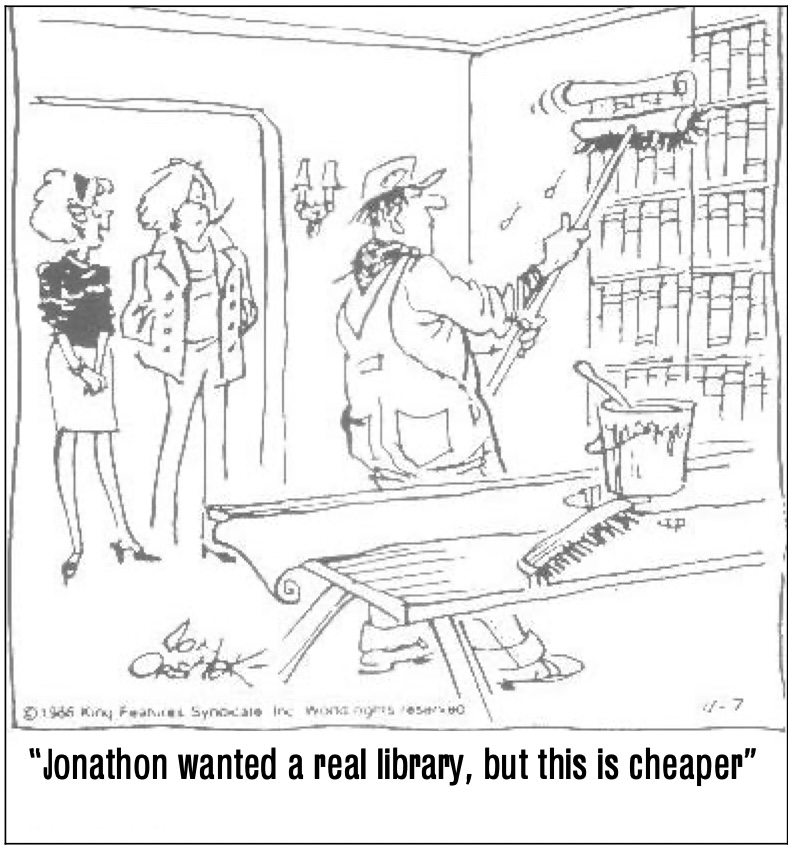
By 1989, state finances were getting tight across the entire country. But none was in a worse condition than Tasmania which had always been a mendicant state, even in the best of times.
I had been invited to speak to the Tasmanian Municipal Government in May on the subject of priority setting on which I had spoken to the Infrastructure Forum the previous year. But that earlier paper was aimed at giving a message to the AFCC, my arch nemesis at the time for their interest – and more especially, their ability – to be funded for infrastructure without any obvious concern for community benefit. I could see that local government required a different story.
In Hobart that morning, the session had been completely concerned with road funding, which they decided could be solved only if the Commonwealth Government would give them more money. I said that while we could fix some problems with more money, we didn’t have enough to fix all problems that way. In those days, I was younger and braver and I told them that they needed to reckon with the fact that there was no more money money coming, that indeed, whatever money the Commonwealth had to give would be reached by those ‘with longer arms than theirs’. Their experience meant they did not doubt me. But, I said, there was an answer: they could spend what they had more wisely. I then explained what they could achieve with asset management.
Happily the paper was well received. I was even asked to give the same paper to the engineers’ conference the following day. And then, about a month or so later, I had an invitation from the Minister of Construction, Resources and Energy, who had been sent a copy of my paper. He could see the value of AM and asked me if I would ‘come down to Tasmania and help him run the show’ . Chapter 12 “Moving on – my story” tells of this incredible opportunity and part 4 of our continuing story will look at how it worked in Tasmania.
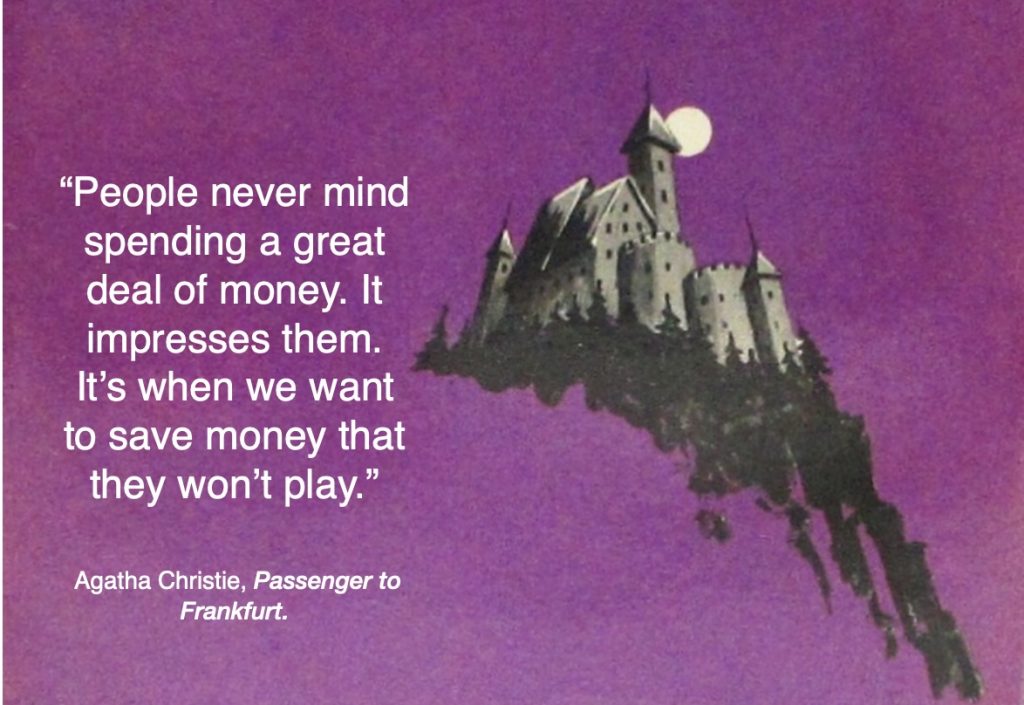
Is this the AM curse? Every election year we are presented with some impossibly expensive infrastructure project which generates great excitement – and acceptance. Invariably these projects are unaccompanied by any detailed analysis, for it is the idea itself that is so compelling, and so analysis just spoils it.
Is this the problem with AM? Are we trying to sell the detail, when all that is wanted – indeed all that can be absorbed by the general public – is the vision? This is not to say that detail is not needed but without an exciting vision, why will people listen?
I am looking for examples of good AM ‘visions’. Do you have, or know of, one?
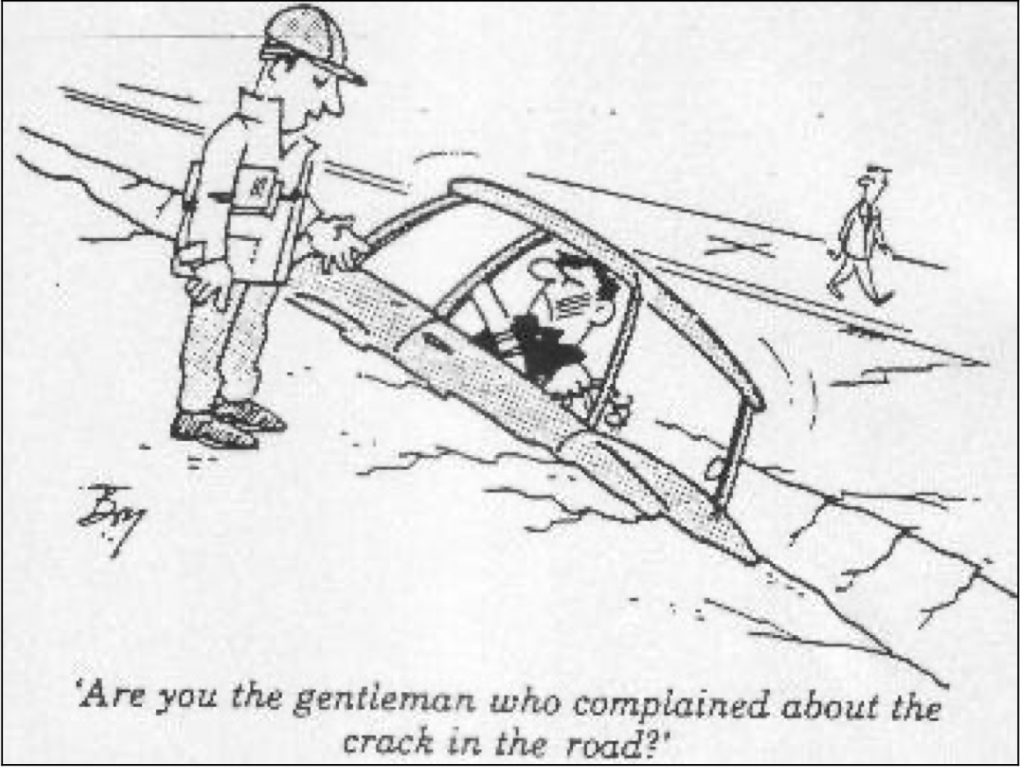
After the Construction Minister’s Conference in 1987 where the PAC work had been presented, I was greeted by my CEO. He was well pleased with our contribution.
Not that the PAC’s work on renewing infrastructure was necessarily understood! “I’m the envy of all”, he said, “because at last we have someone who can tell us how much we should be spending on maintenance”. Intrigued, I asked who this was. “Why, you!” he replied happily. I tried to explain that my expertise was in capital component renewal, not in maintenance, but my protestations were considered modesty and did not diminish his happiness, or belief!
It was generally assumed by maintenance personnel (although not by anyone else) that maintenance should be 2%. (Of what was never well specified). Now it so happened that the PAC calculations of component renewal had averaged out, across all portfolios, to be approximately 2% of the replacement capital value. This was taken as validation of this popular maintenance figure. It was a misinterpretation, but I could see how it arose.
Chapter 11, “Reactions” of The Asset Management Quest (volume 1 of The Asset Management Story) which I have posted today looks at the many and varied ideas that people had about asset management at the beginning.
What are the mistaken ideas that you have to deal with now?

I have known – and quite probably, so have you – many who have fought their way to the end of their studies, perhaps in medicine, law or teaching, only to find that their chosen field is something for which they are quite temperamentally unsuited and they need to start all over again. Fortunately, for those who wish to make their career in the management of physical assets, this fate can be avoided.
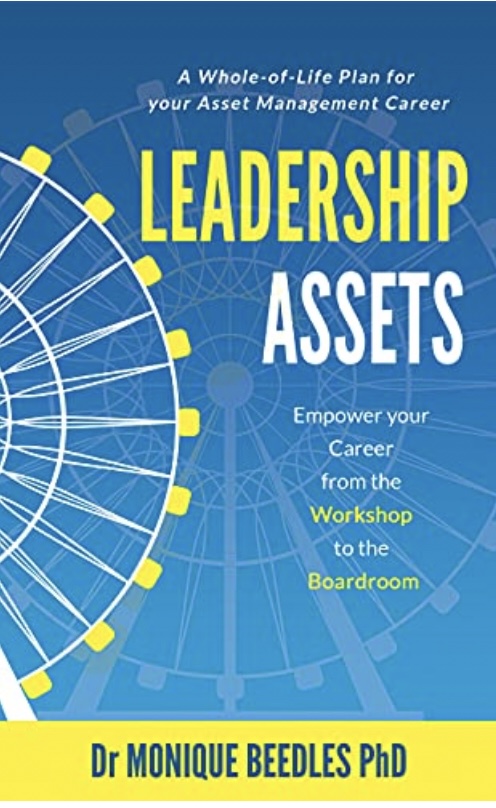
In Leadership Assets, Dr Monique Beedles takes you through four stages of an asset management career – from an Apprenticeship role where your task is to learn and you are leading yourself, through the next stage as Advisor where you lead others and your task is to establish credibility, and on to being an Advocate where you are now ‘leading people who lead people’ and your role is as an influencer, and finally, if you wish, a role as Ambassador where you represent an industry and lead a community.
You don’t need to be at the beginning of your career to benefit greatly from this book, although if you are, you are lucky indeed. Even those considerably advanced along a particular pathway will be encouraged by seeing how much further they may still progress.
Whatever spot on this spectrum you choose for yourself, you will not only find here a clear outline of the key ‘smarts’ you require: ‘tech’ smarts, ‘biz’ smarts and ‘people’ smarts, but also, and importantly, how to develop your strength in the ones you need. This is the main core of the book. It is brightly written, brief, to the point and immensely useful.
This is one of those books that when you find it at the end of your career, as I have done, you are left with a great desire to start all over again – and do it properly!

The late 1980s saw a reduction of grant monies to the States from the Commonwealth with promises of further cuts to come. Peak construction funding was over. This concerned the large private sector firms that had arisen with Commonwealth patronage and they now cast their eye over public works. It is no coincidence that the ‘outsourcing’ movement that had started overseas, should now arrive in Australia. Private Sector think tanks began to speak adversely about government construction performance, whilst at the same time boosting their own chances by promoting the country’s need for more. This was when the word ‘infrastructure’ started to be heard. The Australian Federation of Construction Contractors (AFCC) funded annual ‘Infrastructure Forums’ held in Canberra (near the source of power) and claimed that there was an infrastructure gap.
I challenged this in my first presentation to the Infrastructure Forum in 1988 and said that, since we didn’t know what we had, and we didn’t know what we needed (both of which were indisputably true) we couldn’t know whether we had a gap or not. This annoyed the AFCC and they asked the CSIRO, who organised the forums for them and who had arranged my first presentation, not to invite me again. So they didn’t. But they did arrange for the NCRB (the National Committee on Rational Building) – and a group that the CSIRO was heavily involved in – to be invited and the NCRB asked me to speak on their behalf. So my next address focused on the expensive consequences for the recurrent budget in future years of increasing capital spend this year. They didn’t like this either.
I didn’t have the power that the AFCC had – and, unfortunately, neither did the public works departments around the country. Gradually work was ‘outsourced’ to the private sector and it became obvious that if Asset Management were to grow, it needed to reach out beyond the engineering and corporate planning base that had guided it in its early stages.
That is what I look at in Chapter 10 of our ongoing Asset Management Story, “Architecture, Audit and the Rise of Accounting”, posted today.
Which disciplines, groups, organisations and institutions do we NOW need to reach?
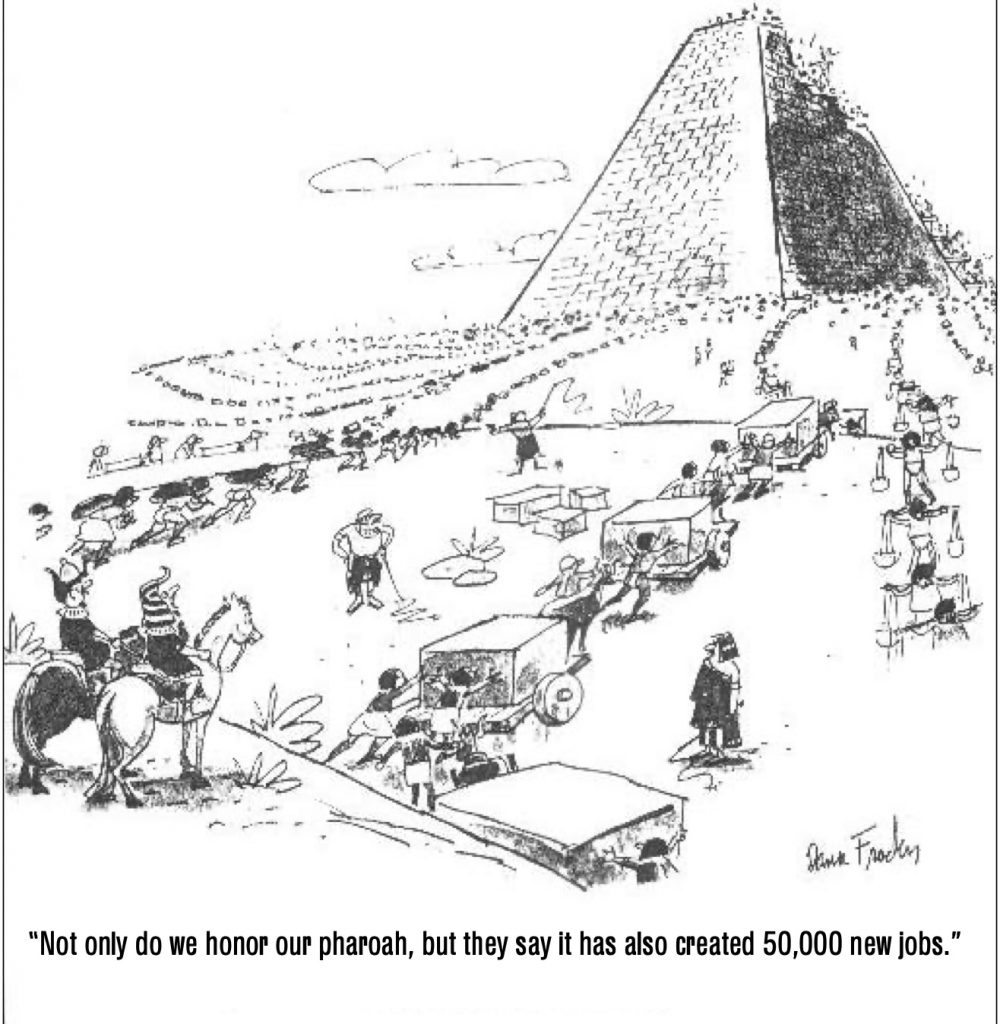
In the late 1950s, peaking in the mid 1960s, there was a great need for infrastructure as our population was growing rapidly. This was a time of full employment. We are again looking to infrastructure to get us out of the downturn that Covid has caused. But is it the ‘right’ solution now?
A little bit of history, 1950 – 1985
With its large land mass and tiny population, Australia had long feared invasion from their crowded northern neighbour, Indonesia. So, after the war it took advantage of the opportunity to build its population by encouraging both refugees and migrants. In addition to the overseas influx, the 1950s also saw the beginnings of the baby boom. Australia’s population rose extremely rapidly in a very short space of time and quickly outstripped growth in housing. At the time, two and even three families might have to share a house.
The private sector could not move fast enough so the Commonwealth took up the challenge.At the time, it was flush with funds for with women now entering the workforce in large numbers, tax revenues were greatly increasing, and with the need for social welfare very low, it could afford to spend – and it did. It created large rental housing estates, hundreds of new suburbs, all with supporting infrastructure in water, electricity, roads, etc. And so, for over 30 years, an entire generation, we experienced rapid construction growth, we didn’t know anything else.
More history, 1985 –
But by 1985, things were changing. Population growth was slowing. The Federal Government was no longer flush with funds. It was time for construction to slow down. The large expansion of infrastructure in the past thirty and more years was also presenting demands of its own. Logically we needed to consider switching our attention from growth to maintenance and over the next ten years this was to become even clearer.
But there was resistance, and it came from three sectors – industry, where the large construction companies built up during the building boom did not wish to see demand for their services reduced; politicians, who saw growth in State GDP and constant infrastructure announcements as proof of their ability to serve the people; and the construction professionals themselves, whose numbers greatly exceeded the fledgling asset management professionals.
With the change in history, came a change in justification for construction
With population increase slowing, and so much infrastructure now completed, we could no longer justify major construction by reference to urgent need – so we changed the justification. It was now argued that infrastructure ‘created’ employment. Many still believe that this is so. But actually, it is public spending that creates jobs – no matter where it is spent, on infrastructure – or on services.
We are also now rethinking ‘the goal’ for infrastructure.
What do you think the goal for infrastructure should now be?

Recent Comments